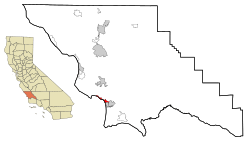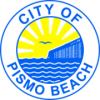Pismo Beach, California facts for kids
Quick facts for kids
Pismo Beach, California
|
|||
|---|---|---|---|
| City of Pismo Beach | |||

Pismo Beaches
|
|||
|
|||
| Nickname(s):
"Pismo"
|
|||
| Motto(s):
Clam Capital of the World
|
|||

Location in San Luis Obispo County and the state of California
|
|||
| Country | United States | ||
| State | California | ||
| County | San Luis Obispo | ||
| Incorporated | April 25, 1946 | ||
| Named for | Tar | ||
| Government | |||
| • Type | Council–manager | ||
| • Body | Pismo Beach City Council | ||
| Area | |||
| • Total | 13.37 sq mi (34.64 km2) | ||
| • Land | 3.50 sq mi (9.06 km2) | ||
| • Water | 9.88 sq mi (25.58 km2) 73.29% | ||
| Elevation | 56 ft (17 m) | ||
| Population
(2020)
|
|||
| • Total | 8,072 | ||
| • Density | 603.74/sq mi (233.03/km2) | ||
| Time zone | UTC−8 (Pacific) | ||
| • Summer (DST) | UTC−7 (PDT) | ||
| ZIP Codes |
93448, 93449
|
||
| Area code(s) | 805 | ||
| FIPS code | 06-57414 | ||
| GNIS feature IDs | 1652776, 2411429 | ||
Pismo Beach is a city located in San Luis Obispo County, along the Central Coast of California. In 2020, about 8,072 people lived there. It's part of an area called the "Five Cities," which includes Grover Beach, Pismo Beach, Shell Beach (which is part of Pismo Beach), Arroyo Grande, and Oceano.
Contents
History of Pismo Beach
The Chumash people were the first people to live in this area. They have lived along the California coast for at least 11,000 years. The name Pismo comes from a Chumash word, pismuʔ, which means "tar." The Chumash used tar from nearby springs to seal their special canoes called tomol. These canoes helped them travel along the coast and to the Channel Islands.
In 1769, a Spanish expedition led by Portolá explored this area. A member of the expedition, Juan Crespí, wrote in his diary that they found a Chumash village near a creek in Pismo Beach.
Pismo Beach was once part of a large Mexican land grant called Rancho Pismo. In 1891, John Michael Price bought most of this land and started the town of Pismo Beach. His old home is now a historical park. Pismo Beach is famous for its clams and attracts over 2.5 million visitors each year.
The first pier in Pismo was built in 1882. A longer pier was built in 1924 by William Woodrow Ward, who allowed everyone to use it. After storms damaged it, the pier was fixed up again in 1985. Pismo State Beach is also named after the city.
The areas known as Shell Beach and Sunset Palisades were once Chumash villages. Shell Beach later became farmland, mostly for growing peas. In 1926, a developer named Floyd Calvert bought and built up Shell Beach as a resort area. After World War II, it became mostly a place where people live. Sunset Palisades, which was once called Oilport, had an oil refinery from 1907 until after World War II. Now, it's also a residential area.
Pismo Clams
The Pismo clam got its name from the long, wide beach where many of them used to be found. There were so many clams that people even used plows to harvest them! People used to come in large numbers to dig for clams during low tides. You can still dig for clams today, but it's harder to find them. This is because too many clams were harvested by people, and also because sea otters, which are protected animals, love to eat clams.
In the 1950s, Pismo Beach called itself the "Clam Capital of the World." Even though this motto isn't used as much now, the city still holds a Clam Festival every October. This festival has fun events like clam chowder competitions and a clam-themed parade.
If you visit Pismo Beach, you'll see a giant concrete clam statue at the end of Price Street. You can also see an eight-inch (20 cm) shell of a Pismo clam (Tivela stultorum) at the Pismo Beach Chamber of Commerce.
Geography and Climate
Pismo Beach covers about 13.5 square miles (35 km2) of land and water. Most of this area, about 73%, is covered by water.
Pismo Creek flows into the Pacific Ocean at Pismo Beach. The southern part of Pismo Beach has sand dunes and eucalyptus trees. These trees attract thousands of migrating monarch butterflies every year from November to February.
Meadow Creek is a small creek that runs through the Pismo Lake Ecological Reserve. Many different animals live here, even though it's close to the city. One animal you might see is the beaver.
Pismo Beach Climate
Pismo Beach has a warm-summer Mediterranean climate. This means it has mild, wet winters and warm, dry summers. Even though it's in a subtropical area, the summers are usually quite cool. The temperature doesn't change much between seasons.
| Climate data for Pismo Beach, California (1991–2020 normals, extremes 1949–2017) | |||||||||||||
|---|---|---|---|---|---|---|---|---|---|---|---|---|---|
| Month | Jan | Feb | Mar | Apr | May | Jun | Jul | Aug | Sep | Oct | Nov | Dec | Year |
| Record high °F (°C) | 85 (29) |
90 (32) |
90 (32) |
101 (38) |
100 (38) |
99 (37) |
102 (39) |
102 (39) |
103 (39) |
99 (37) |
91 (33) |
92 (33) |
102 (39) |
| Mean maximum °F (°C) | 76.0 (24.4) |
78.6 (25.9) |
80.2 (26.8) |
85.4 (29.7) |
83.2 (28.4) |
84.5 (29.2) |
83.0 (28.3) |
81.3 (27.4) |
86.9 (30.5) |
86.9 (30.5) |
82.2 (27.9) |
75.3 (24.1) |
94.1 (34.5) |
| Mean daily maximum °F (°C) | 64.8 (18.2) |
65.1 (18.4) |
67.5 (19.7) |
69.7 (20.9) |
72.3 (22.4) |
70.5 (21.4) |
70.3 (21.3) |
71.4 (21.9) |
71.9 (22.2) |
72.5 (22.5) |
69.0 (20.6) |
65.0 (18.3) |
69.2 (20.7) |
| Daily mean °F (°C) | 54.5 (12.5) |
54.5 (12.5) |
56.9 (13.8) |
59.0 (15.0) |
60.9 (16.1) |
61.0 (16.1) |
62.1 (16.7) |
63.1 (17.3) |
62.7 (17.1) |
62.5 (16.9) |
57.7 (14.3) |
54.3 (12.4) |
59.1 (15.1) |
| Mean daily minimum °F (°C) | 44.2 (6.8) |
44.0 (6.7) |
46.2 (7.9) |
48.2 (9.0) |
49.5 (9.7) |
51.4 (10.8) |
53.9 (12.2) |
54.8 (12.7) |
53.6 (12.0) |
52.6 (11.4) |
46.4 (8.0) |
43.7 (6.5) |
49.0 (9.4) |
| Mean minimum °F (°C) | 34.6 (1.4) |
36.2 (2.3) |
37.0 (2.8) |
38.9 (3.8) |
41.5 (5.3) |
44.3 (6.8) |
47.9 (8.8) |
48.8 (9.3) |
46.4 (8.0) |
42.7 (5.9) |
38.3 (3.5) |
34.1 (1.2) |
31.9 (−0.1) |
| Record low °F (°C) | 24 (−4) |
28 (−2) |
23 (−5) |
27 (−3) |
30 (−1) |
37 (3) |
38 (3) |
39 (4) |
30 (−1) |
32 (0) |
29 (−2) |
21 (−6) |
21 (−6) |
| Average precipitation inches (mm) | 3.48 (88) |
4.00 (102) |
2.98 (76) |
1.00 (25) |
0.46 (12) |
0.15 (3.8) |
0.02 (0.51) |
0.02 (0.51) |
0.08 (2.0) |
0.79 (20) |
1.81 (46) |
3.08 (78) |
17.87 (454) |
| Average precipitation days (≥ 0.01 in) | 8.2 | 8.5 | 7.9 | 4.2 | 1.8 | 0.8 | 0.3 | 0.5 | 1.5 | 3.3 | 5.1 | 7.1 | 49.2 |
| Source: NOAA (mean maxima/minima 1981–2010) | |||||||||||||
Population and People
| Historical population | |||
|---|---|---|---|
| Census | Pop. | %± | |
| 1950 | 1,425 | — | |
| 1960 | 1,762 | 23.6% | |
| 1970 | 4,043 | 129.5% | |
| 1980 | 5,364 | 32.7% | |
| 1990 | 7,669 | 43.0% | |
| 2000 | 8,551 | 11.5% | |
| 2010 | 7,655 | −10.5% | |
| 2020 | 8,072 | 5.4% | |
| 2023 (est.) | 7,948 | 3.8% | |
| U.S. Decennial Census | |||
In 2010, Pismo Beach had a population of 7,655 people. Most of the people were White (91.1%). About 9.3% of the population was Hispanic or Latino.
The average household size was about 2 people. The median age in Pismo Beach was 51.8 years old. This means half the people were older than 51.8 and half were younger.
In 2000, the population was 8,551. The city saw a lot of growth starting in the 1980s. This happened after improvements were made to the city's water and waste systems, which allowed more people to live there.
Economy and Jobs
Pismo Beach has many businesses, especially in tourism, because it's a popular beach destination. Here are some of the top employers in the city, based on a 2020 report:
| # | Employer | # of employees |
|---|---|---|
| 1 | The Cliffs Hotel + Spa | 230 |
| 2 | Keller-Williams | 179 |
| 3 | Dolphin Bay Resort | 124 |
| 4 | City of Pismo Beach | 120 |
| 5 | Martin Resorts (Pismo Lighthouse Suites and
Shore Cliff Hotel) |
100 |
| 6 | United States Postal Service | 85 |
| 7 | SeaVenture Beach Hotel | 74 |
| 8 | Pismo Coast Village RV Resort | 65 |
| 9 | SeaCrest Oceanfront Hotel | 65 |
| 10 | Brad's Restaurant | 60 |
Education
Students in Pismo Beach attend these schools:
- Shell Beach Elementary School
- Judkins Middle School
City Infrastructure
Pismo Beach gets its water from several sources. These include wells in the Santa Maria Groundwater Basin, Lopez Lake, and the State Water Project.
Images for kids
See also
 In Spanish: Pismo Beach para niños
In Spanish: Pismo Beach para niños







